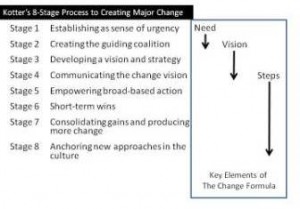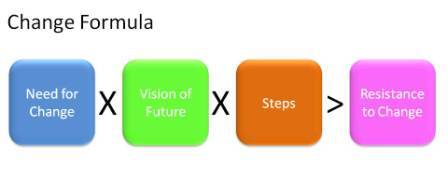If there is a single framework…
…appropriate for just about every dimension of management, and particularly managing others, it is the change formula. And, while I found this concept mentioned directly in several change management references (particularly in the mid-1990’s), I have never seen it attributed to any source nor individual until I recently Googled the term. Thanks to Wikipedia we are now able to research the attribution for the Formula for Change.
The change formula creates a framework with a built-in analogy to an inequality. The analogy simply requires enough content be applied in each variable of the formula (the framework) to overcome the audience’s, group’s or individual’s natural resistance to change (think of Newton’s first law of motion).
Said another way, if any of the key elements of the change formula goes to zero, the inequality will flip and you will not be able to overcome the audience’s, group’s or individual’s natural resistance to change.
The Elements
Need for Change represents dissatisfaction with the present conditions; a compelling gap between “as-is” and the “to-be”.
Vision of the Future represents a positive picture of what is possible in the future. I recently discovered a management consultancy advocating for the vision to be a compelling and emotional story, similar to current thinking in brand marketing.
Steps to achieve the vision represents realistic actions and activities to reach the vision; requires both resources and approach.
Resistance to Change represents the natural and normal resistance to change, either personally or within an organization (e.g., loss of control, too much uncertainty, surprise, confused by change, loss of face, real and perceived threats, post-change issues, past resentments, perception of more work, etc.)
Where can I use it?
Whenever… you think of change, communication, negotiation, etc. For example, I recommended and have seen successful execution of this framework as the outline for communicating strategic direction in a number of organizations, including a domestic insurance company, an African manufacturer and my neighbor’s small business. Further, the change formula can be a framework to define, communicate and understand key drivers of change management.  Even if you do not like the framework, it can be a point of departure in a discussion to create a better way to think of change.
Even if you do not like the framework, it can be a point of departure in a discussion to create a better way to think of change.
(PLEASE LET ME KNOW IF YOU FIND A BETTER ONE!)
Just to demonstrate the universal applicability of the change formula, to the right, I have mapped The Change Formula against John P. Kotter‘s Eight Stage Process of Creating Major Change (Figure 2) from his best selling book Leading Change (Boston: Harvard Business School Publishing, 1996), P 21.
From Industry to Enterprise to Individual change the change formula can effectively help you think about the levers required to overcome the natural resistance to change.



2 Responses
I just finished Chip and Dan Heath’s book Switch, How to change things when change is hard and found it a nice complement to the more strategic/conceptual standard of Prof. Kotter’s Leading Change, but with unique metaphor, tools and techniques
Key metaphor encountered to date is the elephant (emotional) and the driver (rational)
Summary of “How to make a Switch” (p 259)
o Direct the driver
– Follow the bright spots (celebrate successes)
– Script the critical moves
– Point to the destination
o Motivate the elephant
– Find the feeling
– Shrink the change
– Grow your people
o Shape the path (make change easier)
– Tweak the environment
– Build habits
– Rally the herd
I just finished Emerson & Stewart’s “The Change Book” (Alexandria, VA: American Society for Training & Development, 2011) which cites the source of the change formula, with slightly different variables, on page 91 as “Gleicher’s Formula” (c 1969). There is a corroborating citation in Wikipedia, [internet http://en.wikipedia.org/wiki/Formula_for_Change, cited March 19, 2013]